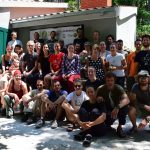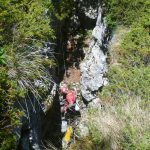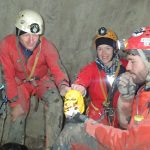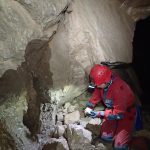A short report from the 1st Biospeleological Expedition – Biokovo 2017
The 1st Biospeleological Expedition – Biokovo 2017 was successfully held from June 17 to June 25 in the Biokovo Nature Park. The expedition was attended by 48 participants, including 43 biospeleologists and/or speleologists from 15 speleological associations, out of which 6 foreigners from Slovenia, Italy and Ireland. The expedition would not be possible without 30 donors, co/sponsors, and sympathizers, whom we sincerely thank for!
After returning from Biokovo Mt, short rest and taking care of first impressions, we made a brief overview of the results that follow in the following releases.
Biospeleology
Preliminary results of the biospeleological research show that we did not make a mistake when Biokovo was selected as an area for the organization of the 1st Biospeleological Expedition in Croatia. Results show that around 10 new species for science have been found in the following groups: leeches (Hirudinea), spiders (Araneae), harvestmen (Opiliones), centipedes (Chilopoda), springtails (Collembola), two-pronged bristletails (Diplura) and beetles (Coleoptera).
In the Mokre noge pit, a new species of leech was found at the depth of around 170 m.
An interesting new species of spider from the genus Troglohyphantes was found in three pits (Led 1, SOB 188 and Jama under Stipkovcem).
Another finding that should be pointed out is the centipede from the genus Geophilus found in the Jama pod Kamenitim vratima pit. The animal was found at 499 m of depth. It represents a second finding of that genus in Croatia and probably a new species for science. It is a troglobiotic specimen, an animal completely adapted to cave life.
In the group of springtails, a new species from the genus Disparrhopalites was found in Pretnerova jama pit and Baba špilja cave. With this discovery, the genus Disparrhopalites is recorded on Biokovo mountain for the first time.
A troglobiotic two-pronged bristletail from the Japygidae family is also very interesting. It is also a new species for science, and it was found in the biospeleologically frequently explored cave Tučepska vilenjača, which seems to hide many more secrets.
Among beetles, four new species have potentially been found. In the Mokre noge pit, two additional specimens of the new genus from subfamily of ant-loving beetles (Pselaphinae) were collected. They are needed for a future scientific description of the genus and species. From the same subfamily, additional specimens of genus Thaumastocephalus, important for a scientific description of species, were collected in Sistem Velika – Velika pit. It is also likely that a new species from the ant-like stone beetles subfamily (Scydmaeninae), genus Euconnus, was found in Jama za Supinom pit. An additional specimen of a new species from the ground beetles subfamily (Trechinae) was collected in the Biokovka pit.
These results will surely be complemented by the following detailed analyses of results. Findings of new species confirm the great richness of Biokovo cave animals, which stands out in Croatia, but also in the world.
Speleology
During the 1st Biospeleological Expedition – Biokovo 2017 a total of 20 pits and caves were explored, of which for 8 topographic maps were made. Below, we highlight research in deep pits.
The Mokre noge pit was the deepest and logistically the most demanding cave explored during the Expedition. The big chamber (200 x 80 m) at a depth of 700 m was biospeleologically explored. Due to time-consuming research, the biospeleologists stayed with the cameraman in the cave for two days. They slept at the bivouac at a depth of 480 m. The shallower parts of the cave were biospeleologically explored during the preliminary preparations in May. All of the speleological equipment was taken out from the cave.
The Jama pod Kamenitim vratima pit was thoroughly biospeleologically explored, an interesting fauna was photographed and all of the speleological equipment was taken out. All used anchorages were marked. The topographic map was made during the preliminary preparations, and the draft is currently being edited. The new depth is 499 meters.
Biokovka pit proved to be very interesting for further speleological and biospeleological research. For this reason, it was equipped with a different type of anchors to a depth of 380 m. The equipment was left inside the cave, to simplify further research.
Although the Pretnerova jama pit was biospeleologically explored on several occasions in recent years, new species for science were discovered during the Expedition. It was equipped to the depth of 220 m during preliminary preparations and biospeleologicaly surveyed in detail during the Expedition. After research, all of the speleological equipment was taken out from the cave and all used anchorages were marked.
The Nova velika pit is one of the sweeter successes of the Expedition. It was subsequently included in the Expedition plan because of its depth, the state of the old topographic map, and lack of biospeleological exploration. After the entrance was not found during the preliminary preparations, it was thought that it would have to be left for another project. However, one day Mr. Samo Puharić who participated in the first exploration of the cave came to the camp during his hike on Biokovo mountain. He kindly took us to the entrance, and in the next actions the cave was equipped up to a depth of 280 m and topographically mapped up to a depth of 265 m. Due to the great speleological potential and poor biospeleological exploration, the Nova Velika has remained equipped for future research.
Because biospeleological research in the Amfora pit were also done in the former years, we did not explore deeper parts of the cave. At the Expedition Amfora was equipped up to a depth of 200 m. It was biospeleologically explored to that point and the speleological equipment was taken out with the help of the speleologists.
Although the speleological research and topographic mapping of the Vilimova jama (A-2) pit was one of the main goals of the Expedition, it became clear that the pit was too complex for research to be carried out in proper quality during the Expedition. With the research of the Vilimova jama (A-2) pit, we entered an interesting pit named A-1, which is 30 meters away from the entrance of the Vilimova jama. Around 100 m was topographically mapped and we think it is connected to Vilimova jama (A-2), but clarification will wait for some future research.
Smaller caves from which additional biological material was needed or where interesting habitats for cave fauna were observed, were also visited. The following caves were explored: Prva velika, Sistem Velika – Velika, Požega, Jama za Supinom, Jama pod Stipkovcem, SOB 188, Led 1, Baba špilja, Šulina jama, Tučepska vilenjača, Lovrićija II and Drinova II. Sistem Velika – Velika i Požega were topographically mapped, and marks on entrances were placed where needed. The thing that makes us particularly happy is the visit to Lovrićija II pit, whose entrance we “misplace” for 15 years. 🙂
Participants: Croatian Biospeleological Society, Breganja Association, Speleological section „Imber“ Omiš, Biology Students Association – BIUS, Speleological Club Ozren Lukić, Figure „EIGHT“, Speleological and alpinistic club „Ekstrem“, Speleological section „St. Mihovil“, Speleological section „Mosor“, Society for cave exploration, Ljubljana, Speleological section Velebit, Speleological club Špiljar, SubBioLab, MOUNTAIN CLUB „VERTIKAL“, Speleological section „Željezničar“, ADIPA, Club Alpinistico Triestino, Circolo Speleologico e Idrologico Friulano, Academic alpine section.
Many thanks to all participants!
- Group photo (photo: M. Barjaković)
- In front of Šulina jama (photo: I. Mišerić)
- Logo of the 1st Biospeleological Expedition – Biokovo 2017.
- Donors, (co)sponsors and sympathizers. Thank you!
- Equipment transport (photo: T. Čuković)
- A well-deserved rest (photo: M. Barjaković)
- A new leech species from Mokre noge pit (photo: T. Delić)
- Measurement of microclimatic parameters at the bottom of Jama pid Kamenitim vratima pit (photo: T. Delić)
- A new sprintail species from the genus Disparrhopalites (photo: M. Lukić)
- A new beetle species from the genus Thaumastocephalus (photo: P. Bregović)
- A new groun beetle species collected from the Biokovka pit (photo: P. Bregović)
- Fauna collection in Mokre noge pit (photo: A. Ćukušić)
- Enternig the Amfora pit (photo: N. Marić)
- Topographical map of Amfora pit
- Rigginh the Biokovka pit (photo: N. Kuharić)
- Topographical map of Biokovka pit
- A snack at -160 m, Jama pod Kamenitim vratima (photo: T. Delić)
- Old topographical map of Jama pod Kamenitim vratima pit
- In front of Jama pod Stipkovcem (photo: G. Quinn)
- Research in Mokre noge pit at a depth of 700 m (photo: A. Ćukušić)
- Mr. Samo Puharić at the entrance of the Nova Velika pit (photo: T. Delić)
- The only known topographical map of Nova velika pit
- Topographical map of Vilimova jama
- Topographic survey of A-1 pit (photo: N. Marić)
- Snow in SOB 188 pit (photo: A. Ćukušić)
- Climb to the road after SOB 188 pit (photo: M. Pavlek)
- In front of the entrance of Baba špilja (photo: Z. Mesić)
- Inerior of Baba špilja (photo: Z. Mesić)
- In Lovrićija II pit (photo: T. Čuković)
- Fauna collection in Jama za Supinom (photo: A. Ćukušić)



































